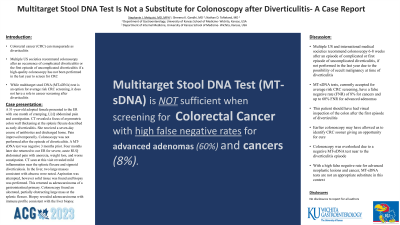Monday Poster Session
Category: Colon
P1718 - Multitarget Stool DNA Test is Not a Substitute for Colonoscopy After Diverticulitis - A Case Report
Monday, October 23, 2023
10:30 AM - 4:15 PM PT
Location: Exhibit Hall

Has Audio

Stephanie J. Melquist, MD, MPH
University of Kansas School of Medicine
Wichita, KS
Presenting Author(s)
Award: Presidential Poster Award
Stephanie J. Melquist, MD, MPH, Shreena K. Gandhi, MD, Nathan D. Tofteland, MD
University of Kansas School of Medicine, Wichita, KS
Introduction: Colorectal cancer (CRC) can masquerade as diverticulitis. Multiple US societies recommend colonoscopy after an occurrence of complicated diverticulitis or the first episode of uncomplicated diverticulitis if a high-quality colonoscopy has not been performed in the last year to screen for CRC. While multitarget stool DNA (MT-sDNA) test is an option for average risk CRC screening, it does not have a role in cancer screening after diverticulitis.
Case Description/Methods: A 51-year-old adopted female presented to the ER with one month of cramping, LLQ abdominal pain and constipation. CT revealed a focus of asymmetric colon wall thickening at the splenic flexure described as early diverticulitis. She received a seven-day course of antibiotics and discharged home. Pain improved temporarily. Colonoscopy was not performed after the episode of diverticulitis. A MT-sDNA test was negative 3 months prior. Four months later she returned to our ER for severe, acute RUQ abdominal pain with anorexia, weight loss, and worse constipation. CT scan at this visit revealed mild inflammation near the splenic flexure and sigmoid diverticulosis. In the liver, two large masses consistent with abscess were noted. Aspiration was attempted, however solid tissue was found and biopsy was performed. This returned as adenocarcinoma of a gastrointestinal primary. Colonoscopy found an ulcerated, partially obstructing large mass at the splenic flexure. Biopsy revealed adenocarcinoma with immune profile consistent with the liver biopsy.
Discussion: Multiple US and international medical societies recommend colonoscopy 6-8 weeks after an episode of complicated or first episode of uncomplicated diverticulitis, if not performed in the last year due to the possibility of occult malignancy at time of diverticulitis. MT-sDNA tests, currently accepted for average risk CRC screening, have a false negative rate (FNR) of 8% for cancers and up to 60% FNR for advanced adenomas. This patient should have had visual inspection of the colon after the first episode of diverticulitis. Earlier colonoscopy may have allowed us to identify CRC sooner giving an opportunity for cure. Colonoscopy was overlooked due to a negative MT-sDNA test near to the diverticulitis episode. With a high false negative rate for advanced neoplastic lesions and cancer, MT-sDNA tests are not an appropriate substitute in this context.
Disclosures:
Stephanie J. Melquist, MD, MPH, Shreena K. Gandhi, MD, Nathan D. Tofteland, MD. P1718 - Multitarget Stool DNA Test is Not a Substitute for Colonoscopy After Diverticulitis - A Case Report, ACG 2023 Annual Scientific Meeting Abstracts. Vancouver, BC, Canada: American College of Gastroenterology.
Stephanie J. Melquist, MD, MPH, Shreena K. Gandhi, MD, Nathan D. Tofteland, MD
University of Kansas School of Medicine, Wichita, KS
Introduction: Colorectal cancer (CRC) can masquerade as diverticulitis. Multiple US societies recommend colonoscopy after an occurrence of complicated diverticulitis or the first episode of uncomplicated diverticulitis if a high-quality colonoscopy has not been performed in the last year to screen for CRC. While multitarget stool DNA (MT-sDNA) test is an option for average risk CRC screening, it does not have a role in cancer screening after diverticulitis.
Case Description/Methods: A 51-year-old adopted female presented to the ER with one month of cramping, LLQ abdominal pain and constipation. CT revealed a focus of asymmetric colon wall thickening at the splenic flexure described as early diverticulitis. She received a seven-day course of antibiotics and discharged home. Pain improved temporarily. Colonoscopy was not performed after the episode of diverticulitis. A MT-sDNA test was negative 3 months prior. Four months later she returned to our ER for severe, acute RUQ abdominal pain with anorexia, weight loss, and worse constipation. CT scan at this visit revealed mild inflammation near the splenic flexure and sigmoid diverticulosis. In the liver, two large masses consistent with abscess were noted. Aspiration was attempted, however solid tissue was found and biopsy was performed. This returned as adenocarcinoma of a gastrointestinal primary. Colonoscopy found an ulcerated, partially obstructing large mass at the splenic flexure. Biopsy revealed adenocarcinoma with immune profile consistent with the liver biopsy.
Discussion: Multiple US and international medical societies recommend colonoscopy 6-8 weeks after an episode of complicated or first episode of uncomplicated diverticulitis, if not performed in the last year due to the possibility of occult malignancy at time of diverticulitis. MT-sDNA tests, currently accepted for average risk CRC screening, have a false negative rate (FNR) of 8% for cancers and up to 60% FNR for advanced adenomas. This patient should have had visual inspection of the colon after the first episode of diverticulitis. Earlier colonoscopy may have allowed us to identify CRC sooner giving an opportunity for cure. Colonoscopy was overlooked due to a negative MT-sDNA test near to the diverticulitis episode. With a high false negative rate for advanced neoplastic lesions and cancer, MT-sDNA tests are not an appropriate substitute in this context.
Disclosures:
Stephanie Melquist indicated no relevant financial relationships.
Shreena Gandhi indicated no relevant financial relationships.
Nathan Tofteland indicated no relevant financial relationships.
Stephanie J. Melquist, MD, MPH, Shreena K. Gandhi, MD, Nathan D. Tofteland, MD. P1718 - Multitarget Stool DNA Test is Not a Substitute for Colonoscopy After Diverticulitis - A Case Report, ACG 2023 Annual Scientific Meeting Abstracts. Vancouver, BC, Canada: American College of Gastroenterology.

